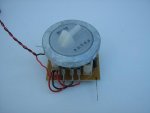Hi,
I'm working on upgrading a project that acts as a drag strip for human powered go karts. I originally built it a few years ago using a old laptop and a velleman usb interface adapter. I now wish to rebuild some of it using a picaxe instead so it is more mobile and less power hungry.
The old design used large paddle switches (2 bits of wood and a hinge) for the starting sensor and a plank of wood with a vibration sensor for the end of the strip. Whilst these worked fairly well kids tended to have trouble aiming the cart correctly to hit the wood and on hard ground the vibration sensors tended to trigger too early as the carts came thundering towards them. Its also quite tough to get them to stay still.
As part of the rebuild I would like to also redesign the sensors. I have a few ideas and I was wondering if anybody could comment on them if they have tried something similar or suggest any alternatives.
1. 2 LDR's and a comparator.
One LDR is always looking up at the sky the other is in the middle of the lane also facing up with a shroud reducing its visible angle. When the cart goes over it will cause the comparator to trigger. Only problem I see is that the driver will need to drive the kart directly over the LDR unless I make several spanning the lane.
2. IR break beam
I'm not sure if this will work as some karts have a very small surface area or wheels with spokes. I'm thinking the beam will be big enough to shine around these small blockages on some karts.
3. Hose with LED and LDR at either end
Stretch a hose out across the lane with a LED one end and a LDR the other. When the kart hits the hose it should block the light assuming the LDR reacts quick enough. Getting the hose to stay in a straight line however could be tricky.
Any ideas?
I'm working on upgrading a project that acts as a drag strip for human powered go karts. I originally built it a few years ago using a old laptop and a velleman usb interface adapter. I now wish to rebuild some of it using a picaxe instead so it is more mobile and less power hungry.
The old design used large paddle switches (2 bits of wood and a hinge) for the starting sensor and a plank of wood with a vibration sensor for the end of the strip. Whilst these worked fairly well kids tended to have trouble aiming the cart correctly to hit the wood and on hard ground the vibration sensors tended to trigger too early as the carts came thundering towards them. Its also quite tough to get them to stay still.
As part of the rebuild I would like to also redesign the sensors. I have a few ideas and I was wondering if anybody could comment on them if they have tried something similar or suggest any alternatives.
1. 2 LDR's and a comparator.
One LDR is always looking up at the sky the other is in the middle of the lane also facing up with a shroud reducing its visible angle. When the cart goes over it will cause the comparator to trigger. Only problem I see is that the driver will need to drive the kart directly over the LDR unless I make several spanning the lane.
2. IR break beam
I'm not sure if this will work as some karts have a very small surface area or wheels with spokes. I'm thinking the beam will be big enough to shine around these small blockages on some karts.
3. Hose with LED and LDR at either end
Stretch a hose out across the lane with a LED one end and a LDR the other. When the kart hits the hose it should block the light assuming the LDR reacts quick enough. Getting the hose to stay in a straight line however could be tricky.
Any ideas?

